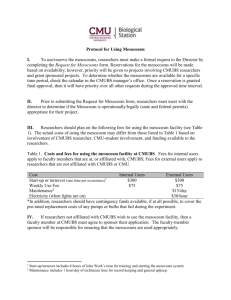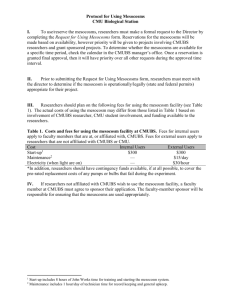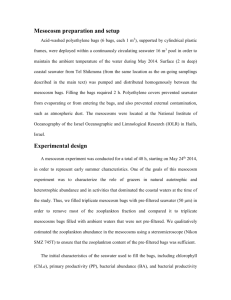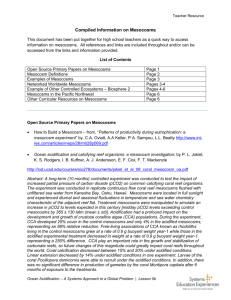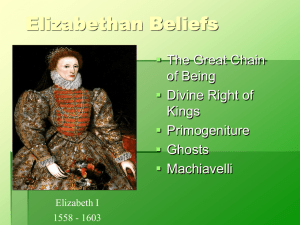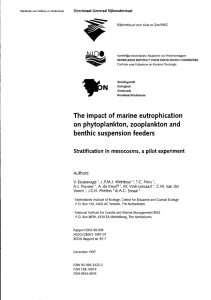MESOCOSM PROJECT - LaPazColegio2014-2015
advertisement
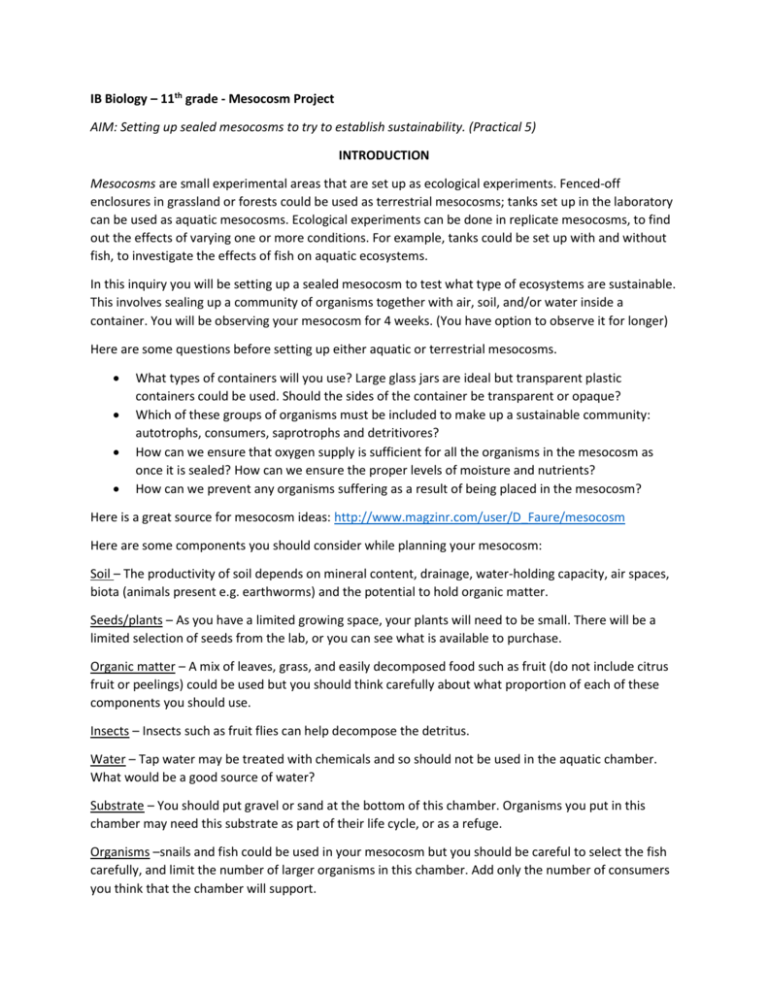
IB Biology – 11th grade - Mesocosm Project AIM: Setting up sealed mesocosms to try to establish sustainability. (Practical 5) INTRODUCTION Mesocosms are small experimental areas that are set up as ecological experiments. Fenced-off enclosures in grassland or forests could be used as terrestrial mesocosms; tanks set up in the laboratory can be used as aquatic mesocosms. Ecological experiments can be done in replicate mesocosms, to find out the effects of varying one or more conditions. For example, tanks could be set up with and without fish, to investigate the effects of fish on aquatic ecosystems. In this inquiry you will be setting up a sealed mesocosm to test what type of ecosystems are sustainable. This involves sealing up a community of organisms together with air, soil, and/or water inside a container. You will be observing your mesocosm for 4 weeks. (You have option to observe it for longer) Here are some questions before setting up either aquatic or terrestrial mesocosms. What types of containers will you use? Large glass jars are ideal but transparent plastic containers could be used. Should the sides of the container be transparent or opaque? Which of these groups of organisms must be included to make up a sustainable community: autotrophs, consumers, saprotrophs and detritivores? How can we ensure that oxygen supply is sufficient for all the organisms in the mesocosm as once it is sealed? How can we ensure the proper levels of moisture and nutrients? How can we prevent any organisms suffering as a result of being placed in the mesocosm? Here is a great source for mesocosm ideas: http://www.magzinr.com/user/D_Faure/mesocosm Here are some components you should consider while planning your mesocosm: Soil – The productivity of soil depends on mineral content, drainage, water-holding capacity, air spaces, biota (animals present e.g. earthworms) and the potential to hold organic matter. Seeds/plants – As you have a limited growing space, your plants will need to be small. There will be a limited selection of seeds from the lab, or you can see what is available to purchase. Organic matter – A mix of leaves, grass, and easily decomposed food such as fruit (do not include citrus fruit or peelings) could be used but you should think carefully about what proportion of each of these components you should use. Insects – Insects such as fruit flies can help decompose the detritus. Water – Tap water may be treated with chemicals and so should not be used in the aquatic chamber. What would be a good source of water? Substrate – You should put gravel or sand at the bottom of this chamber. Organisms you put in this chamber may need this substrate as part of their life cycle, or as a refuge. Organisms –snails and fish could be used in your mesocosm but you should be careful to select the fish carefully, and limit the number of larger organisms in this chamber. Add only the number of consumers you think that the chamber will support. TIMELINE Thursday June 4nd – You should investigate different options for creating a sealed mesocosm. You should use class time to create a list of materials that you will need as well as a description of how your mesocosm will be set up. This must be emailed to Dr. Natalie before the end of class! Fri June 5th – Mon June 8th: Over the weekend you must complete your mesocosm design and obtain ALL your material to set up your mesocosm. You must check in on Monday (in person or via email) to let me know that you have obtained all your materials! Tues June 9th: In class you will fully set up your mesocosm. This means you MUST bring all your materials to class. You will receive a grade for your preparation and your set-up. Fri June 12th, 19th 26th, July 3rd: Weekly observations of your mesocosm (see below). Tues July 7th: Final mesocosm project is due. This includes the observations and conclusions (below). Due Date June 4 June 8 June 9 June 12 June 19 June 26 July 3 July 7 Task Investigate mesocosms, design your project, create material list and clear description Complete design and materials obtained Set up mesocosm during class period. place in designated area. Take photos. Observation 1 – See description below Must include photos Observation 2 – See description below Must include photos Observation 3 – See description below Must include photos Observation 4 – See description below Must include photos Final Mesocosm Project Due Proof Email description to Dr. Natalie Check in (email) Dr. Natalie Upload photos to google drive Record data on table, upload photos to drive Record data on table, upload photos to drive Record data on table, upload photos to drive Record data on table, upload photos to drive All data analyzed, photo record complete Complete? OBSERVATIONS Each week you can make observations of your bottle ecosystems. Each observation should include: the date of your observations the number of days the ecosystem has been running qualitative observations (e.g. plant growth, decomposition rate, turbidity of water, status of the species present, numbers of organisms) quantitative observations (plant height, number of organisms) You must record your observations in an organized data record. You will have to submit this data record in your final report. You should also take digital photos of your mesocosm at least during each observation. These photos will be uploaded to google drive. As part of your final report you should create a visual presentation of the change over the four weeks. FINAL REPORT At the conclusion of this inquiry you will submit for grading a final project report which clearly and concisely documents the following: 1. DESIGN: This should include detailed drawings of your mesocosm, a written description of the materials contained including an explanation of the role of each material in the function of the mesocosm. 2. PREDICTION: A clear statement of what you predict will occur in your mesocosm along with an explanation of why you have made those predictions. 3. OBSERVATIONS: The data collected (including the data sheets) as well as a description of the quantitative and qualitative data collected. 4. ANALYSIS: A careful analysis of the change over time in your mesocosm. This must include at least one appropriate graph. You should also include a link to your photographic evidence. 5. CONCLUSION: Identify the role of each biotic and abiotic factor in the functioning of your mesocosm. For the organisms, you should identify the appropriate trophic levels and apply the correct terminology. Explain the flow of energy and nutrients between different organisms. You should draw a clearly labeled food web. 6. EVALUATION: Discuss the limitations to your design and what you might change to improve your design. Your final report should be completed as a Google Doc and shared with the class, along with all visual information.
